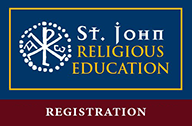Bulletins
December 30, 2012
Download the Bulletin as a PDFYour neighbors’ Christmas lights may already be dimmed and their Christmas trees long hauled away in the trash recycling. The Christmas Season has only just begun. We celebrated the great saints of the first three days of the Christmas Octave. Dec. 26: St. Stephen, the first of the first deacons (Acts 6, 5-8) and the first Christian martyr (Acts 6, 5-7,60; 22,20). Dec. 27: St. John, the Apostle, the Evangelist, the Beloved. Dec. 28: the Holy Innocents, the baby boys aged two and younger who were slaughtered because of Herod the (not so) Great’s fear of a spiritual force that would upset his political power (Mt. 2, 16-18).
This weekend we celebrate the Feast of the Holy Family. Tuesday we celebrate the Solemnity of Mary the Mother of God, which used to also be the great feasting day of college football but now it is only a religious holiday. Catholics in America have two of our adopted own to celebrate this coming week: St. Elizabeth Ann Seton on January 4 and St. John Neumann on January 5.
And that’s just the Twelve Days of Christmas, which culminate in the Solemnity of the Epiphany, which is traditionally observed on January 6 but in modern times has been pushed to a weekend, happily occurs on a Sunday this year.
Then there is a whole additional week of Christmas, concluding with the Feast of the Baptism of the Lord. A day later the ordinary Masses will return to green. But the Traditional Calendar stays in Christmas Season for a full forty days, all the way until February 2, the Feast of the Purification of the Blessed Virgin Mary, now known as the Presentation of the Lord. Hopefully winter will have started by then.
Your old friend, Dom Prosper Gueranger, observes in The Liturgical Year that “the custom of celebrating the Solemnity of our Saviour’s Nativity by a feast or commemoration of forty days’ duration is founded on the holy Gospel itself; for it tells us that the Blessed Virgin Mary, after spending forty days in the contemplation of the Divine Fruit of her glorious Maternity, went to the Temple, there to fulfil, in most perfect humility, the ceremonies which the Law demanded of the daughters of Israel, when they became mothers.”
The same good abbot asks the question “But what is the characteristic of Christmas in the Latin Liturgy? It is twofold: it is joy, which the whole Church feels at the coming of the divine Word in the Flesh; and it is admiration of that glorious Virgin, who was made the Mother of God. There is scarcely a prayer, or a rite, in the Liturgy of this glad Season, which does not imply these two grand Mysteries: an Infant-God, and a Virgin-Mother.”
So, for a long time to come may we say:
Merry Christmas! Happy Christmas! ¡Feliz Navidad! Buon Natale! Joyeux Noël! Frohe Weihnachten! Boldog Karácsonyt! Maligayang Pasko!
Go Redskins!
Fr. Christopher J. Pollard



